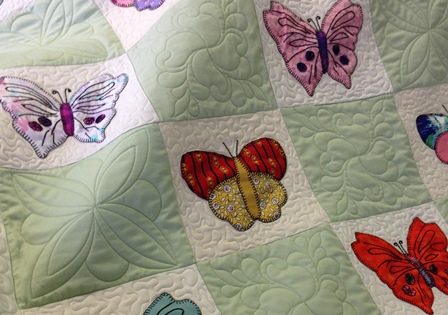Pricing your longarm quilting services using the price-per-square-inch model

Many people purchase an APQS longarm quilting machine with the dream of starting their own business. They envision themselves surrounded by happy customers alongside stacks of beautiful quilt tops awaiting their creative touch and the ability to determine their own work schedule.
While owning your own longarm quilting business can be all of that and more, starting up your small business can be intimidating. After all, we all want to be paid a fair wage for our labor but how do you determine what that should be?
The first thing to do is determine what your target hourly wage is. How much would you like to make per hour? You must keep in mind that you also have some overhead to cover alongside your actual labor. After all, you need to pay off the machine, cover the electrical costs required to run it and pay for studio space. Don’t forget you’ll have other costs too, like needle, thread, batting and a host of other costs.
I try to keep my hourly target at $25/hour. Once I know what my hourly target rate is, I can start to track how much time I’m spending quilting tops to make sure I’m charging the appropriate rate to my customers. You’ll also need to know if you are looking to replace full time income or if you just want to earn enough money to pay off that batik habit! For me, I’m a single mom of triplets and this is how I buy milk. Quilting is my full time profession. Determining how much income you’d like to bring in a month will also help you evaluate if you’re taking in enough quilts and charging enough money for your services.
The most common way folks price machine quilting service is by the square inch. Take the length and width measurement and multiply it together to get the total square inches for the quilt top. Multiply that number by the different pricing tiers based on the level of quilting requested by the customer.
For example, I charge two cents a square inch for all over, edge to edge quilting. If a customer brings me a queen sized quilt and it measures 90 x 100, the total square inches is 9,000.
90” x 100”= 9,000 square inches x .02/sq inch= $180 labor charge
That is just my labor charge. I also charge an $8/quilt needle and thread fee to cover those costs. I sell batting and backing (which I’ve bought wholesale) or the customer can bring their own. I also have a binding service and I charge for things like making labels, hanging sleeves and piecing backings. The point is that the total cost to my customer may be more than just my labor, and I have the opportunity to make money on those additional charges as well.
So how long will it take me to do that queen sized quilt? It depends on the pattern chosen and how skilled I am. When I first started quilting it took me longer to quilt. Now my skills have improved and I’m faster. Initially, I’d count on about 4-5 hours to finish a queen sized quilt using a wide open, easy edge to edge design. Have you already done the math in your head?
$180 labor charge/5 hours= $36/hour
That sounds pretty awesome, right? Keep in mind that hourly rate must also cover the time it took me to drive to my local quilt shop, meet with the client, drive back home AND the time it will take me after it is finished to drive back to the quilt shop to deliver the finished quilt to my client and drive back home. So let’s add another hour to that equation.
$180 labor charge/6 hours= $30/hour
Now I need to factor in the cost of electricity, the cost of the patterns, the cost of the machine, the cost of the space in my home where I’m working, the cost of my business insurance, health insurance, the cost of my website, flyers, advertising, accounting software, the time it takes to input everything into my software, and the time it takes to determine what quilting designs should be used where on my customer’s quilt.
Once all of those costs are factored into my hourly wage I’m likely down to around $20/hour. Thankfully, as I gained more experience, I will be able to finish that queen in 4 hours or less, which helps bring my hourly wage back in line with the hourly wage I targeted at the beginning.
The ultimate goal is to charge a rate that pays your labor AND your overhead so you can make a livable wage. Don’t forget that you are a small business owner and while your quilty friends are lovely people you must still stand up for yourself and charge a respectable wage!
Also, don’t think your customers are only located within driving distance to you. With the internet, you can have customers all over the country! All you need is a website. As with all small businesses, you must dedicate yourself to giving your business the loving care it needs to grow. A successful quilting business doesn’t just happen overnight and it takes hard work. However, the freedom I get from being a small business owner allows me to be the mommy I want to be because I control my own schedule and can be there for my kids when they need me.
I love owning my own business and watching it grow. If you’d like to see my full pricing list, please take a look over on my website. Obviously my pricing structure won’t be exactly the same as yours but sometimes it’s helpful to see what others are doing. You’ll notice my charges for custom and show quilts are fairly high (and I’m no longer doing this level of quilting for others). Right now I‘m focusing primarily on edge to edge quilting as I have so many projects I’m working on that I no longer have the time to do high level quilting for others.
There are other ways to price your machine quilting service including by the hour, by the bobbin and by the size of the quilt. Find the way you like best and the way that your customers will understand the easiest. Don’t forget that there are other charges involved beyond just your labor that will help increase the profitability of your company.
Are you ready to take the leap and see where your quilting dreams will take you? Hop over to our APQS forums and get involved in the business section. Post your questions and look through the questions others have posted. Learn more about how to market yourself and what steps you can take to launch your business. Just don’t forget to charge a respectable wage. Honor yourself and your craft. You’ll be much happier in the end.
Contact your local APQS dealer for more information about how to launch your quilting business. We have sample business plans, consultation forms, and other financial documents that will help you realize your small business dreams!
Angela Huffman is an APQS dealer and the owner of Quilted Joy Studio in Louisville, Kentucky.



